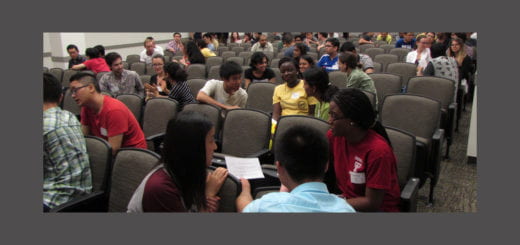Card Claim: An Activity to Challenge Misconceptions about Cultural Appropriation

By Kate Pride-Brown, Assistant Professor, History and Sociology
I have taught HTS 3055: Globalization in the Modern World three times in the past. Each time, I have a section on “Globalization and Culture.” We discuss identity, hybridity, concern about cultural erosion, cultural isomorphism, and similar topics. However, I have never (deliberately) included cultural appropriation in this section. I think the reason is because the term has become so widely used in the public sphere – and my scholarly understanding of it differs substantially from what I hear “out there” – that I just didn’t want to go there. Cowardly, perhaps, but I thought I had plenty to offer the students when it came to globalization and culture without it.
The thing is, cultural appropriation always came up anyway. Students would bring it up, and I then had to do on an off-the-cuff answer to their questions and comments – which I am pretty good at doing, but always left me irritated because it took time away from the lesson I had prepared and I hadn’t wanted to talk about it anyway. So, this semester, I decided that I would deliberately assign a day to discuss cultural appropriation, knowing that I might ruffle some feathers with some people who are wedded to a more normative and less empirically-sound understanding of the concept. I assigned a reading from Borrowed Power and hoped for the best.
But I didn’t want to just talk at the students tell them that what they all thought about cultural appropriation was wrong (not that they are always wrong, but…usually they are). I wanted to get them to understand that claims-making is an interpretive process. I also wanted to arm them with an understanding of power, so that they can themselves better analyze what is at stake in instances of cultural appropriation. (And not think that somehow no one is ever allowed to do anything other than what their own cultural group has ever done until the end of time, or that they are supposed to turn off their brains and cease to be thoughtful and creative human beings whenever they encounter ideas, objects and behaviors that are not of their own culture – as if that were even possible.)
To help them gain the understanding of claims-making as an interpretive process, and to help them think about cultural appropriation in terms of power, I thought it would be fun to have them interpret their own claims about it. I plan to pass out note cards and ask them to write down an example of cultural appropriation. Then I will have them get into groups and give the cards back to the groups for them to then discuss whether or not this example is, in fact, cultural appropriation, and justify the claim by explaining how the appropriation impacts the distribution of power between the cultural groups to the benefit of the more powerful group.
Activity Implementation
I began the class by passing out index cards and asking the students to write down an example of “cultural appropriation.” Then I collected the cards.
I then asked how many of them had heard of “cultural appropriation” before the reading this week. All the hands went up. Then I asked how many of them had learned about it in a classroom setting. All the hands went down.
I explained to them that concepts are often developed in academia, and then migrate into the public sphere and take on a life of their own. So they may have heard of “cultural appropriation” and think they know what it is, but they may not have the same understanding that scholars have.
(And scholars don’t always even agree with one another, either, I added!)
Then I explained why I was concerned when I heard examples from the public sphere that suggested that one should never adopt any aspect of a culture that was not one’s own.
We talked about what culture is, what it does, how it works, and the process of perpetual reinterpretation of cultural codes. Since cultures are mutable and reinterpreting/adopting other cultural content is as old as humanity itself, I put to rest the notion that doing so was somehow “not allowed.”
I then explained the theoretical perspective (postmodernism) that suggests that objects, words and actions have no inherent meaning, that we define these meanings socially, and that people make competing claims about definition and interpretation. None is inherently valid. Neither are claims of cultural appropriation inherently valid.
But then I re-emphasized that there is still something about borrowing that is worth critiquing, and that there may be a means to think through competing claims, despite their differing epistemologies. I explained that what is really at stake is power. Culture is powerful, and it can be used by different groups to enhance or diminish the power of others. We talked about different kinds of power relationships and how culture can play a role in these.
Then came the activity. I had them form groups and I divided the notecards between the groups. I asked them to discuss each example and determine whether or not it was indeed a form of cultural appropriation by identifying the power relationship involved. I had them write their answers on the back of the card and collected the cards at the end.
The discussion was lively and long. Students were deeply engaged. I came around to help students if they needed it. There were some really interesting points and counterpoints, and everyone was eager to think through the complexity of power relationships. It was probably the most engaged group discussion session I’ve coordinated this semester.
There was one group that had a less than robust discussion than the others because three of their four notecards contained the same example (Halloween costumes). I suppose I could have gone over the cards and made sure the examples were diverse before handing them out. I hadn’t wanted to take away class time in sorting the cards, but in the future, I think that would probably be worth the extra couple minutes to make sure that doesn’t happen again.
We came back together and discussed how globalization matters for these debates, because as the world becomes more integrated there is 1) more opportunity for borrowing, and 2) more diverse groups are inhabiting the same social space. When different societies have different interpretations, it doesn’t really matter because these are different societies – they are not expected to share understandings. Arguments about the proper use of cultural artifacts suggests that we are negotiating shared definitions and interpretations about these things, building toward a shared understanding – which is the basis of any society. We see more arguments about “cultural appropriation” because we are, more and more, part of the same society.
At the end of class I asked the students if they felt the activity had helped them better understand cultural appropriation and if they thought other students would appreciate it if I did it again. They nodded their heads vigorously. I got multiple thumbs up. Some vocalized their affirmation. One young man said, “I learned so much I didn’t know about.”
I’ll call it a win.
This piece was written as part of the Class of 1969 Teaching Fellows and to earn a Reflective Teaching Badge issued by the Center for Teaching and Learning by Georgia Tech. Please visit our website if you are interested in learning more about the program or to submit a reflection.




